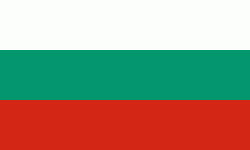Bulgarian lev
лв
The lev (лев, plural: лева, левове / leva, levove; ISO 4217 code: BGN; numeric code: 975) is the currency of Bulgaria. In old Bulgarian the word "lev" meant "lion", the word 'lion' in the modern language is lаv (in Bulgarian: лъв). The lev is divided in 100 stotinki (стотинки, singular: stotinka, стотинка). Stotinka in Bulgarian means "a hundredth" and in fact is a translation of the French term "centime". Grammatically the word "stotinka" comes from the word "sto" (сто) - a hundred.Since 1997, the lev has been in a currency board arrangement with initially the Deutsche Mark at a fixed rate of BGL 1000 to DEM 1. After the introduction of the euro and the redenomination of the lev in 1999, this has resulted in a fixed rate to the euro of BGN 1.95583 : EUR 1. Since 2020, the lev has been a part of the European Exchange Rate Mechanism (ERM II). The lev is scheduled to be supplanted by the euro on 1 January 2024.
The currency's name comes from the archaic Bulgarian word "lev," which meant "lion."
The lion is the national symbol of Bulgaria during the centuries.
In Bulgaria, the lion features on numerous historical monuments. The oldest images, found on slates in the city of Stara Zagora, date back to 9-10 century AD. A lion is depicted on The Madara Horseman- an impressive medieval rock relief carved into a towering rock plateau in North Eastern Bulgaria, which is on UNESCO’s World Heritage List. In the Middle Ages Bulgarian kings, such as Ivan Shishman, one of the last rulers of the Second Bulgarian kingdom, celebrated the lion as a symbol of power.
In the time of Bulgarian national awakening in the years of Ottoman bondage, the lion was considered and widely used as a major national symbol. Paisii of Hilendar, a discerning monastic and a key Revival figure, mentioned in his ground-breaking tome Istorija Slavjanobolgarskaja that Bulgarians had a lion on their kings’ royal seal: a symbol of the bravery, courage and invincibility of Bulgarian warriors, who fought “like lions”.
Lion images on revolutionary flags, used in the 1876 freedom-seeking April uprising, provide a proof that the lion continued to be considered as a national symbol. In the immediate period leading up to the revolt, revolutionary flags were made, featuring a golden lion rampant and the motto ”Freedom or Death”. These flags, most often hand-made by local teachers or icon painters, have been preserved in Bulgarian museums to the present day. Most flags were made of green silk and had a painted or embroidered lion on them, in a heraldic posture and trampling over the Crescent- the symbol of the Ottoman Empire. The same image can be seen on items of one-time rebel outfits such as hats and buttons. In Bulgarian folklore and Revival Literature, these lion depictions were called lion signs attributed to the Bulgarian revolutionaries´ image. “Young Bulgarian heroes...lion signs on their foreheads, fire blazing in their eyes”, says a most popular Bulgarian Revival period song.
Country
-
Bulgaria
Bulgaria (България), officially the Republic of Bulgaria, is a country in Southeast Europe. It is situated on the eastern flank of the Balkans, and is bordered by Romania to the north, Serbia and North Macedonia to the west, Greece and Turkey to the south, and the Black Sea to the east. Bulgaria covers a territory of 110994 km2, and is the sixteenth-largest country in Europe. Sofia is the nation's capital and largest city; other major cities are Plovdiv, Varna and Burgas.
One of the earliest societies in the lands of modern-day Bulgaria was the Neolithic Karanovo culture, which dates back to 6,500 BC. In the 6th to 3rd century BC the region was a battleground for ancient Thracians, Persians, Celts and Macedonians; stability came when the Roman Empire conquered the region in AD 45. After the Roman state splintered, tribal invasions in the region resumed. Around the 6th century, these territories were settled by the early Slavs. The Bulgars, led by Asparuh, attacked from the lands of Old Great Bulgaria and permanently invaded the Balkans in the late 7th century. They established the First Bulgarian Empire, victoriously recognised by treaty in 681 AD by the Eastern Roman Empire. It dominated most of the Balkans and significantly influenced Slavic cultures by developing the Cyrillic script. The First Bulgarian Empire lasted until the early 11th century, when Byzantine emperor Basil II conquered and dismantled it. A successful Bulgarian revolt in 1185 established a Second Bulgarian Empire, which reached its apex under Ivan Asen II (1218–1241). After numerous exhausting wars and feudal strife, the empire disintegrated and in 1396 fell under Ottoman rule for nearly five centuries.
